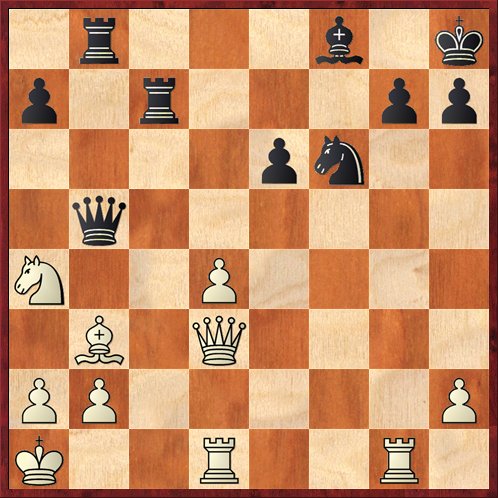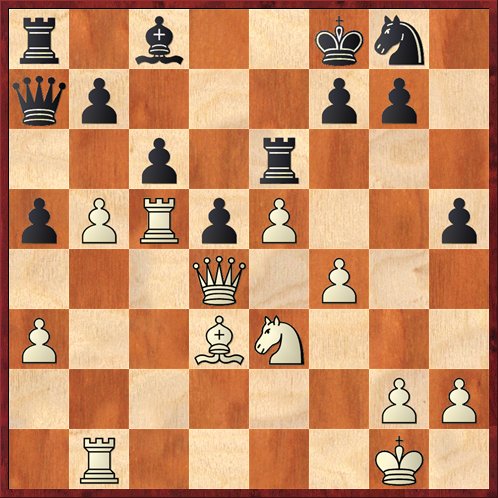My alert correspondent, Jim Krooskos, spotted an occurrence of the Hook and Ladder Trick in the first round of the U.S. Women’s Championship (currently taking place in St. Louis). Here’s the position. Defending champion Irina Krush was White, and Sabina Foisor was Black:
Black to play and win.
Krush has just played 30. Bb3, which was probably the worst move on the board. How can Foisor take advantage?
Here’s another Hook and Ladder sighting, from a game between Viktor Tkachenko (a master) and Zhan Makarkin (an expert) from the Voronezh Open-B in 2008. I stumbled upon it in Chessbase when I was researching something completely different (I was looking for recent Danish Gambit games). Here it’s a little bit trickier, because there doesn’t seem to be an open file yet.
White to move. How can White force a win of material?
While you’re thinking about those puzzles, let me update the news from the U.S. Championship. The men’s tournament has sixteen players, divided into two eight-man round robins (group A and group B). Two from each group will move on to the semifinals. After three rounds, Gata Kamsky and Yuri Shulman (the two finalists in last year’s tournament) are leading group A with 2-1 scores, along with Alexander Ivanov.
Group B has been more surprising so far. Sam Shankland, whose “retirement” seems to have been forgotten, is the only player with a 2½-½ start. He outplayed Larry Christiansen in round 3 in a Q+2B versus Q+B+N endgame. With my limited understanding of chess, I thought there was no way that Christiansen could lose. All the pawns were on one wing, which favors the knight. However, what I didn’t fully appreciate was the MONSTER, also known as the unopposed bishop. Sam’s bishop and queen formed a battery on the a1-h8 diagonal to threaten mate on g7. Because Christiansen didn’t have a bishop of the right color he had to continually babysit the pawn on g7 with his queen or knight. It turned out that the lack of mobility cost him in the end.
In spite of that defeat, Christiansen is still very much in the running; he is tied for second in group B with Robert Hess at 2-1.
In the women’s tournament, the big surprise was Foisor’s upset of Krush in round one. Foisor is still in the lead with a 2½-½ score, with the favorites, Krush and Anna Zatonskih, tied for second at 2-1.
The funny thing is that I had never heard of Sabina Foisor until last week, when I wrote this blog post about chess-playing families! She is a WGM and her parents are both IM’s, which led me to call them the world’s number one chess-playing family. It would be truly prophetic if she proved me right by winning the U.S. Women’s Championship!
Here is the URL for all the information about the tournament — schedules, crosstables, PGN files, etc.
Now for the answers to those two puzzles:
(1) Foisor’s winning move against Krush was 30. … Rc1+! A classic hook and ladder that forces Krush to lose her queen. Krush resigned immediately.
(2) Tkachenko’s winning move against Makarkin was 26. Nxd5! If Black takes, then 26. … cd 27. Rxc8+ springs the trap. A very cute extra twist is that if Black plays 27. … Re8, attempting to avoid the loss of the queen and remain with even material, White wins the queen anyway with 28. b6! The queen has no escape!
I really like this setting of the hook and ladder motif, where the trap is doubly hidden because the c-file is not open in the initial position and Black’s queen is not under attack in the initial position; both of these key ingredients emerge during the combination.
By the way, Makarkin avoided the hook and ladder by playing 26. … b6, but then Tkachenko won a second pawn with 27. Rxc6. With an extra pawn and an utterly dominating position, he won the game very shortly thereafter.




